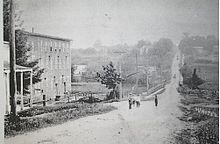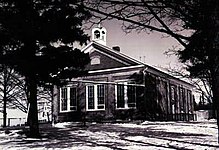User:Majorville
Hamlet of Whitevale, Ontario | |
|---|---|
 Whitevale, 1877 | |
| Coordinates: 43°53′14″N 79°09′48″W / 43.8871°N 79.1634°W | |
| Country | Canada |
| Province | Ontario |
| Region | Durham Region |
| Established | 1820's |
| Population (1996) | |
• Total | 240 |
| 255 persons (2016 Projection -Pickering Official Plan) | |
| Time zone | UTC−5 (Eastern (EST)) |
| • Summer (DST) | UTC−4 (Eastern (EDT)) |
| Website | www.whitevale.ca |
Whitevale (formerly Majorville) is a hamlet located in the city of Pickering in Durham Region, Ontario, Canada.
History
[edit]Whitevale was an excellent example of ninteenth century industry concentrating by a power source and then expanding of its own accord.[1]

Settlement
[edit]The hamlet began in the 1820’s when John Major built a saw mill. The hamlet was known as the village of Major or Majorville, because of the mill and the number of Majors who lived close by on the 5th Concession line.[2]
Around 1855 Truman P. White bought the saw mill, built a grist mill and a cooperage; and in 1866 built a planing factory. The village owed so much of its development and business prosperity to T.P. White that in acknowledgement, it adopted Whitevale as its permanent designation.[3]

Growth
[edit]The newly named village of Whitevale may be said to have had its beginning in the year 1855. In that year Donald McPhee opened the first store and T.P. White erected a grist mill that cost $10,000, which for equipment far surpassed all others in the township at the time. In 1866 he built a large planing mill and in 1867 a large four storey brick woolen mill, that cost about $30,000 and was the pride of the village. The woolen mill was leased and operated for some years by Mr. Ellis, the grist mill in the year 1867 to 1874 by the Spink brothers and the sawmill by the Besse brothers.[4]

Prosperous Times
[edit]Whitevale during these years was a busy place. In 1890 Whitevale contained a stave and heading factory and a barrel factory both owned and operated by the Spink brothers; three general stores, one owned by James Taylor and Donald McPhee; a wagon and carriage factory, operated by the Pollard brothers; a cheese factory, owned and operated by P.R. Hoover and Co.; the merchant and tailoring firm of J. Rose and Son; the shoemaker shops of John Allen and D. Moodey; the butcher shop of Israel Burton and the tinsmith shop of S.B. Wigmore. In addition, Whitevale contained two blacksmiths, two wagon shops, a school house, undertakers, harness shop, grist mill, brush factory grindstone factory, barber shop, three dressmakers, three gardeners, money order and post offices, hotel, brass band, two churches and four lodges.[5]
Important Historical Structures
[edit]
|

|

|
| Whitevale School
Construction date: 1865 The Trustees of the School purchased this property in 1864 from James White for $150.00. This new school was to replace the 1842 school building located on the corner of the John Sleigh Farm, Concession 5, Lot 27. The construction of the present building was financed by Truman P. White. The school was used for educational purposes until 1968 when it was closed due to the government policy of regionalizating district schools, it is now a private residence.[6] |
T.P. White's House[7] | George Gilchrist's House
Construction date: Mid 1860's This house may have been built by George Gilchrist , a local planer and later owner of a sash and door factory, in the mid 1860s after he purchased the property from T.P White. It is considered to be one of the more important heritage buildings in Whitevale.[8] |
Fires
[edit]
Fires destroyed many of Whitevale’s booming industries and continually changed the face of town. A public hall which had been erected in 1860 was also lost due to fire. A carriage factory and the cooperage went in 1874. The woolen mill was the next to experience a fire several years later, but the brick walls remained standing. This was later followed by the destruction of the planing mill and the grist mill, which was then being operated by Mr. White himself. The planing mill was rebuilt on the site of the grist mill and subsequently burned in 1899. The grist mill machinery was rebuilt inside the fire-damaged brick walls of the old woolen mill. [9] A devastating fire leveled the converted grist mill in 1961, but a modern feed mill was erected on the same site in 1962.[10]
Floods
[edit]
The Whitevale Bridge has suffered from at least three separate occasions from flooding. In 1929 a heavy flood completely washed out the bridge. In October 1954, Hurricane Hazel the bridge, mill, and dam went out when Duffins Creek overflowed. [11]Finally, in June 2008 the concrete bridge suffered minor damage when heavy rains washed out a small section.
Historic Organizations
[edit]- Lodge No. 282 of the Ancient Order of United Workmen was organized in Whitevale on June 17th, 1887. The following were the charter members: George Burton, C.C. Reesor, William Boyd, J. Thornton, William Coakwell, E. Nighswander, S. B. Lynde, John Turner, W.R. Barton, Walter S. Major and A.E. Major. In 1900 the lodge was transferred to Green River.
- Court Pride of the Vale, No. 7144 of the Ancient Order of Foresters was organized on July 26th, 1885. The following were the charter members: J. Kirton, J. Ferguson, A. Besse, Dr. W. H. Carleton, Levi Cooper, John Burkholder, S. Pennock, William Lount, S. Mitchell, Robert Birnie, Donald R. Beaton, Fred Fuller and Charles C. Reesor.
- Brougham Lodge No. 155 of the Independent Order of Odd Fellows was instituted in the village of Brougham on January 29th, 1875 but was destroyed by a fire in December 1892. In August 1893, a duplicate charter was issued and the lodge moved to Whitevale.[12]
Present Day
[edit]
Businesses
[edit]- Healing Centre
- Craft Shop
- Ice Cream Shop
- Dinner Theatre
- Golf and Country Club
Facilities
[edit]- Pickering Public Library
- Whitevale United Church
- Whitevale Cemetery
- Whitevale Community Centre
- Whitevale Park
- Seaton Hiking Trail (along Duffins Creek)
Film Shoots
[edit]
Televison
[edit]- The Canadian television show Paradise Falls' was filmed in the village of Whitevale[13]
Movies
[edit]- Parts of David Cronenberg's film Dead Zone were filmed in Whitevale (1983)[14]
- Academy Award Nominated film,Lars and the Real Girl (2007)
- A Home At The End of the World (2004)
Notes
[edit]- ^ Pickering Public Library Local History Collection
- ^ Pickering Public Library Local History Collection
- ^ Wood, W.R. (1911). Past Years in Pickering. Toronto: William Briggs.
- ^ Wood, W.R. (1911). Past Years in Pickering. Toronto: William Briggs.
- ^ Wood, W.R. (1911). Past Years in Pickering. Toronto: William Briggs.
- ^ Pickering-Ajax Digital Archive
- ^ Pickering-Ajax Digital Archive
- ^ Pickering-Ajax Digital Archive
- ^ Wood, W.R. (1911). Past Years in Pickering. Toronto: William Briggs.
- ^ Pickering-Ajax Digital Archive
- ^ Pickering-Ajax Digital Archive
- ^ Wood, W.R. (1911). Past Years in Pickering. Toronto: William Briggs.
- ^ The Internet Movie Database (IMDb)
- ^ The Internet Movie Database (IMDb)

